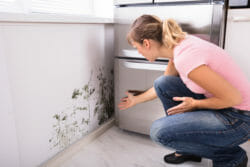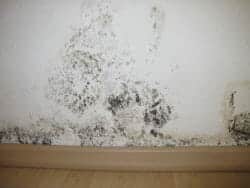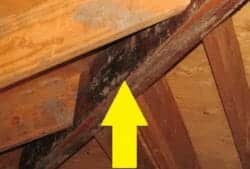Mold In A Home: Getting Rid Of It, Insurance and Key Facts
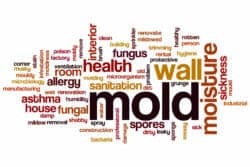
Mold in a home can be a health concern or a structural concern. People will often use terms such as Black Mold, toxic mold or the term “Building Cancer” when referring to molds affecting health or the structural aspects of the home. These terms often scare homeowners unnecessarily because every home has some level of mold in them, but only specific ones are serious.
Determining the seriousness is usually based on:
- type of mold
- amount of mold
- location of the mold
- the health of those exposed to it
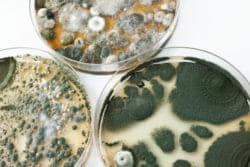
The CDC states that Molds are a “fungi that can be found both indoors and outdoors. No one knows how many species of fungi exist, but estimates range from tens of thousands to perhaps three hundred thousand or more. Molds grow best in warm, damp, and humid conditions, and reproduce by making spores which can not be seen by the naked eye but often spreads by floating through the air. Mold spores can survive harsh environmental conditions, such as dry conditions, that do not support normal mold growth.”
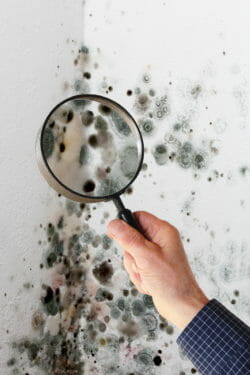
Warning signs of mold in your home
There are signs that may warn a homeowner that there is the possibility of mold in their home:
- Dark colored stains or splotches, sometimes a dark gray, black or greenish coloration.
- Moldy or musty type odors.
- Allergy type symptoms like watery eyes, sneezing, running nose, etc.
These are just a few warning sings. Testing and conducting a thorough look around the home, including hidden places you have not thought of, will provide much more information.
Molds affecting a home’s structural integrity
Serpula lacrymans is a decay fungi that overtime can destroy the structural integrity of a home. If not addressed the wood beams, rafters, trusses and studs may deteriorate to the point that they will structurally fail. At times, contractors refer to this as “Building Cancer.” (Read about “Building Cancer” mold)
Lumberyard mold (i.e. Ceratocystis and Ophiostoma species) are another type of molds that may develop into problematic issues for a home builder, but much less of an issue than Serpula lacrymans. (Learn about Lumberyard” mold in a home)
Molds affecting health

According to the EPA (Environmental Protection Agency) molds have the potential to cause health problems. Molds produce allergens (substances that can cause allergic reactions), irritants, and in some cases, potentially toxic substances (mycotoxins). Inhaling or touching mold or mold spores may cause allergic reactions in sensitive individuals.
Exposure to moldy environments can cause a variety of health issues, or none at all, depending on a person’s own health and sensitivity. For some people symptoms that there may be mold in a home may be:
- Sneezing
- Wheezing
- Runny or stuffy nose
- Coughing or postnasal drip
- Throat irritation
- Watery or itchy eyes
- Dry or scaly skin.
People with mold allergies may have more severe reactions to molds present in a home. Ones who have a weakened or compromised immune system need to be more careful and pro-active if there is mold evidence. If a person feels that they are experiencing a health problem due to mold, they should consult with their doctor.
Testing, remediation and removal of mold
Without moisture, mold will usually not survive or will become dormant. If the mold becomes dormant, say due to lack of moisture, it may become active again years later if it comes into a moisture source again.
Homeowners and buyers will often spot or suspect that mold is in their home. They may observe moisture stains, dark discoloration on the walls or ceilings, musty or moldy odors or experience health issues that are often related to mold. These type of things may trigger a desire to look into the possibility of mold in a home and if discovered, to remove it. (Hidden places where you may find mold)
Owners may hire a professional mold inspector or remediation company to come to their home, take air samples and inspect it for mold. Others, may purchase a mold testing kit on line, take air samples with it, and then send the samples to a lab for testing.
Removal of the mold may be done by a professional mold removal and remediation company or by the homeowner themselves. In general, it is much easier to remove mold from hard surfaces such as counter tops, bathroom and kitchen tile and other non-porous surfaces. In porous surfaces like drywall, it is much more difficult to remove mold; therefore, in these types of materials it is common to remove them and replace with new.

Insurance – Homeowners & Health
Health insurance
Many health insurance policies will cover heath care treatment issues involving mold. It is wise to contact your doctor and health insurer to determine if you’re covered and if so, to what extent.
Homeowners insurance
Structural issues and damage to your home may only be covered under special conditions and circumstance, however there are often strict dollar limits and a great many exclusions when mold is involved. Many policies do not cover mold damage.
Bottom Line
Every home has mold in it, some of which may be serious. Wise homeowners should be proactive in preventing mold to develop and remove any mold discovered in their home. Failure to do so may create health issues and even result in structural damage in some cases.
